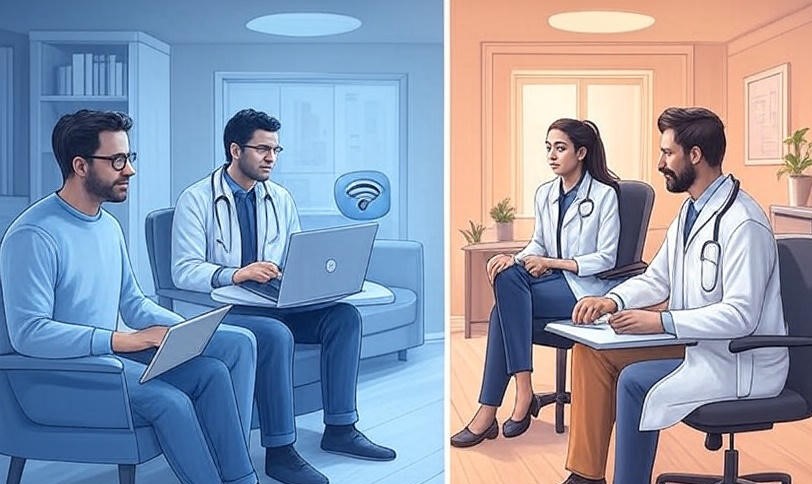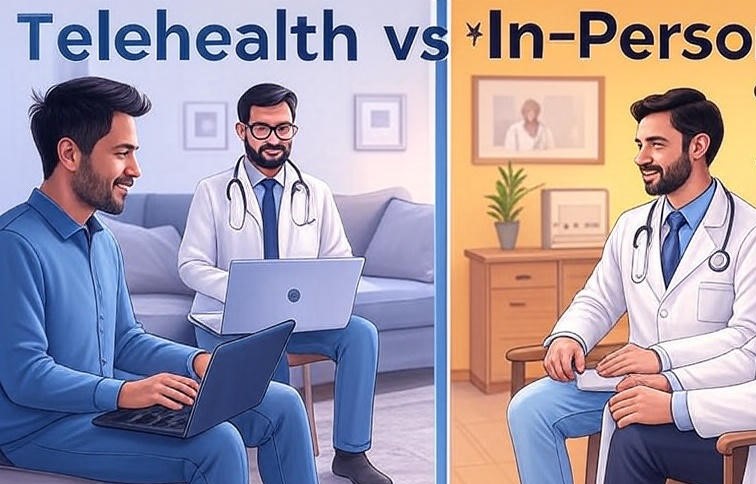Healthcare has entered a transformative era where technology is reshaping how medical services are delivered. Patients now have multiple options for seeking care, ranging from traditional in-person visits to virtual consultations conducted via telehealth platforms. The discussion of Telehealth vs In-Person Visits: Pros & Cons has become critical for both healthcare providers and patients who want to make informed decisions regarding their health.
Telehealth allows patients to connect with healthcare professionals remotely through video calls, phone consultations, and mobile apps. In-person visits, on the other hand, involve face-to-face interactions that enable physical examination, immediate testing, and direct treatment. While both methods aim to deliver quality healthcare, they each have unique advantages, limitations, and practical applications.
This article will provide an in-depth exploration of telehealth and in-person visits, comparing their benefits and drawbacks, sharing real-world examples, analyzing patient experiences, and offering expert guidance. By understanding these nuances, patients can confidently decide which approach is most suitable for their individual needs.
Table of Contents
ToggleUnderstanding Telehealth
What is Telehealth?
Telehealth is a method of delivering healthcare services remotely using digital communication tools. It encompasses video consultations, phone calls, online chat platforms, and remote patient monitoring. Telehealth is particularly useful for patients who face barriers to visiting a healthcare facility, such as those living in rural areas, those with limited mobility, or those managing chronic conditions that require regular monitoring.
Telehealth services include:
-
Routine check-ups and follow-up visits
-
Chronic disease management (e.g., diabetes, hypertension)
-
Mental health therapy and counseling
-
Minor urgent care evaluations
-
Remote prescription management
Advantages of Telehealth
-
Accessibility
Telehealth breaks geographic barriers, making healthcare accessible to patients in remote or underserved areas. Research shows that rural patients are 30% more likely to use telehealth for routine care than traveling long distances to clinics. -
Convenience
Virtual consultations save travel time, reduce waiting room delays, and fit into busy schedules. Patients can attend appointments from the comfort of their homes. -
Cost-Effectiveness
Telehealth often reduces expenses associated with travel, childcare, and missed work. It can also lower overhead costs for healthcare providers. -
Chronic Disease Monitoring
Remote devices allow continuous monitoring of conditions like hypertension, diabetes, and heart disease. Providers can intervene early when readings indicate a potential problem. -
Reduced Risk of Infection
Telehealth minimizes exposure to contagious diseases, particularly beneficial during flu seasons or pandemics. -
Expanded Mental Health Access
Teletherapy sessions allow patients to access counseling services conveniently and privately, which may improve treatment adherence.
Limitations of Telehealth
-
Limited Physical Examination
Certain conditions require hands-on assessment, palpation, or imaging that cannot be done remotely. -
Technology Barriers
Patients must have a reliable internet connection, compatible devices, and digital literacy to participate in telehealth effectively. -
Privacy Concerns
Sharing sensitive medical information online introduces potential cybersecurity risks if platforms are not secure. -
Insurance Limitations
Coverage for telehealth services varies by insurer and region, which may affect affordability.
Understanding In-Person Visits
What is an In-Person Visit?
In-person visits involve direct interaction between a patient and healthcare provider at a clinic, hospital, or other healthcare facility. These visits allow providers to perform physical exams, order tests, conduct procedures, and make real-time clinical decisions.
Advantages of In-Person Visits
-
Comprehensive Assessment
Providers can perform detailed physical examinations, collect samples for lab tests, and immediately interpret results. -
Immediate Intervention
Acute conditions, injuries, or complex illnesses can be addressed without delay, reducing complications. -
Patient-Provider Relationship
Face-to-face interactions often foster trust, improve communication, and enhance adherence to treatment plans. -
Diagnostic Accuracy
Direct observation and hands-on assessment improve the accuracy of diagnoses compared to virtual evaluations. -
Access to Full Resources
In-person visits provide immediate access to imaging, laboratory testing, and specialist referrals.
Limitations of In-Person Visits
-
Accessibility Challenges
Patients living far from healthcare facilities or with mobility issues may struggle to attend in-person visits. -
Time and Scheduling
Travel, waiting rooms, and administrative procedures can make visits time-consuming and inconvenient. -
Higher Costs
Facility overhead, staffing, and additional procedures often make in-person visits more expensive.
Comparing Telehealth vs In-Person Visits
Aspect |
Telehealth |
In-Person Visits |
|---|---|---|
Accessibility |
High, especially for remote patients |
Limited by location and mobility |
Convenience |
Flexible scheduling, no travel |
Travel and waiting required |
Cost |
Often more affordable |
Higher due to facilities and procedures |
Diagnostic Accuracy |
Limited to visual and verbal cues |
Full physical exams possible |
Patient Comfort |
Comfortable for routine and follow-up care |
Preferred for complex evaluations |
Technology Dependency |
Requires internet and devices |
Minimal technology needed |
Infection Risk |
Low, remote consultations |
Higher, physical presence required |
Patient Experiences & Case Studies
Case Study 1: Chronic Disease Management
Jane, a 55-year-old patient with hypertension, uses a telehealth platform to monitor her blood pressure daily. Her doctor adjusts medication in real time based on the readings, preventing hospitalizations. Telehealth proved convenient, cost-effective, and efficient for her ongoing care.
Case Study 2: Acute Injury
Mark, a 35-year-old athlete, experienced severe knee pain after a fall. He required imaging and a physical examination, which could not be performed remotely. In-person care allowed immediate intervention, accurate diagnosis, and proper treatment planning.
Survey Insights
A recent survey found:
-
72% of patients reported satisfaction with telehealth for routine care
-
85% preferred in-person visits for acute or complex conditions
These experiences highlight the complementary nature of telehealth and in-person visits.
Expert Opinions & Recommendations
Healthcare professionals agree that telehealth and in-person care serve distinct but overlapping purposes:
-
Dr. Smith, a family physician: “Telehealth is excellent for follow-ups and mental health support, but it cannot replace the comprehensive evaluation offered during in-person visits.”
-
Telehealth expert Dr. Johnson: “Hybrid models combining virtual check-ins with periodic face-to-face visits are the future of patient-centered care.”
Experts recommend assessing the condition’s severity, patient preferences, and resource availability when choosing between the two options.
Tips for Making the Right Choice
-
Assess Your Condition: Minor ailments or routine follow-ups are well-suited for telehealth; serious or acute issues require in-person evaluation.
-
Consider Convenience: Telehealth is ideal for patients with mobility issues or tight schedules.
-
Evaluate Technology: Ensure access to devices, reliable internet, and basic digital literacy.
-
Check Insurance Coverage: Confirm telehealth services are covered under your plan.
-
Factor in Personal Comfort: Choose the format where you feel confident and safe discussing your health.
Future of Healthcare: Integrating Telehealth and In-Person Care
Healthcare is moving toward a hybrid model, combining the convenience of telehealth with the thoroughness of in-person visits. Innovations like wearable devices, AI-powered monitoring, and remote diagnostics are further enhancing telehealth’s effectiveness.
Hybrid care ensures:
-
Continuous monitoring of chronic conditions
-
Reduced hospital visits without compromising care quality
-
Greater flexibility for patients and providers
Experts predict that by 2030, hybrid models will become the standard, improving accessibility, patient satisfaction, and healthcare outcomes globally.
Expanded FAQs
-
Can telehealth replace all in-person visits?
No, telehealth complements in-person care but cannot fully replace it. Physical examinations, imaging, and complex procedures require face-to-face visits. -
Are telehealth services safe and secure?
Yes, when using HIPAA-compliant platforms. Ensure your devices are secure, avoid public Wi-Fi, and follow privacy guidelines. -
Which conditions are ideal for telehealth?
Chronic disease management, mental health therapy, routine follow-ups, minor urgent care, and medication management. -
Is telehealth covered by insurance?
Many insurers cover telehealth, but coverage may vary by plan and region. -
How do I prepare for a telehealth visit?
Ensure a quiet environment, test your device, gather medical records, and have questions ready. -
What if I need a prescription?
Telehealth providers can prescribe medications electronically, but certain controlled substances may require in-person evaluation. -
Can children use telehealth?
Yes, pediatric telehealth is widely available for routine check-ups, minor illnesses, and behavioral health services. -
What about emergencies?
Telehealth is not suitable for life-threatening emergencies like heart attacks, strokes, or severe injuries. -
Can telehealth improve patient adherence?
Yes, remote monitoring and easy follow-ups help patients stick to treatment plans. -
Is telehealth suitable for mental health care?
Absolutely. Virtual therapy sessions provide privacy, convenience, and access to specialized providers.
Conclusion
The choice between Telehealth vs In-Person Visits: Pros & Cons depends on a patient’s condition, needs, and preferences. Telehealth offers convenience, accessibility, cost-effectiveness, and safety from infectious exposure, while in-person visits provide thorough assessments, immediate intervention, and higher diagnostic accuracy.
Ultimately, a hybrid approach—leveraging both telehealth and in-person care—is likely the most effective strategy for modern healthcare. Patients should consult healthcare providers, consider their unique circumstances, and select the care model that optimizes health outcomes.













